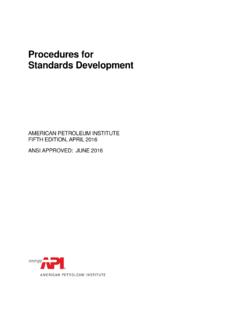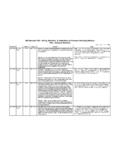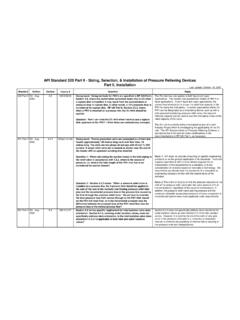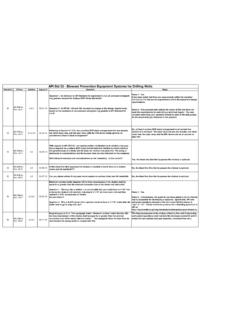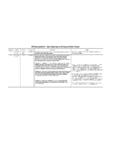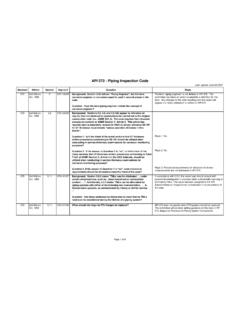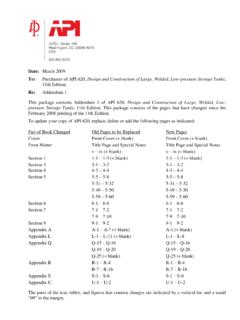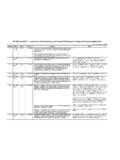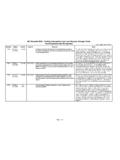Transcription of 200120803 API RP 545 Revision 1 - My Committees
1 Page 1 of 19 Agenda Item: RP545 Revision 1 Title: Revision 1 for API RP545 Recommended Practice for Lightning Protection of Aboveground Storage Tanks for Flammable or Combustible Liquids Date: July 21, 2012 Contact: George L. Morovich (SCAST SG Design) Tank and Environmental Technologies, Inc PH: 979-247-4812 EM: Purpose: A discussion was held at the Spring 2012 CRE meeting on RP545 Work Group Objectives, with the following items agreed for consideration in the next Revision of API RP 545: 1. Address the findings of the drain dry tank operations risk assessment conducted at the Fall 2011 meeting in Toronto.
2 2. Adopt language similar to API 653 with respect to a defined major repair being a trigger for updating an EFR tank to meet API RP 545 requirements. 3. Consider language that uses known lightning strike zones (similar to earthquake zones) that identifies areas that are applicable to API RP 545 requirements based upon high lightning incident areas (risk). 4. Consider language regarding a covered external floating roof (EFR) that points the reader to Appendix G in API 650 for Structurally-Supported Aluminum Dome Roofs . 5. Reconciliation of API RP 545 and NFPA 780 (Lightning Protection Code) regarding retroactivity requirements for submerged shunts.
3 6. Metal Thickness and Tank Configuration 7. Durability of Materials Item 2 above was deleted because the API 545 document already points to API 653 regarding maintenance. Item 5 above is already complete. A proposal to NFPA 780 regarding retroactivity was submitted and accepted at the recent NFPA 780 ROP meeting. Source: Committee request Revision : 0 for Ballot from Spring 2012 and RP 545 Work Group Meetings Impact: To allow increased options based on Risk Analysis Rationale: To clarify application, indicate exceptions / exemptions and allow Owner options for on Risk Analysis Proposal.
4 New text is red underlined Committee DraftPage 2 of 19 Recommended Practice for Lightning Protection of Aboveground Storage Tanks for Flammable or Combustible Liquids Downstream Segment API RECOMMENDED PRACTICE 545 FIRST EDITION, OCTOBER 2009 Foreword This Recommended Practice (RP) is based on the accumulated knowledge and experience of purchasers and manufacturers of welded steel oil storage tanks of various sizes and capacities for internal pressures not more than kPa (2 1/2 psi) gauge. This RP is meant to be a purchase specification to facilitate the manufacture and procurement of storage tanks for the petroleum industry.
5 If the tanks are purchased in accordance with this RP, the purchaser is required to specify certain basic requirements. The purchaser may want to modify, delete, or amplify sections of this RP, but reference to this RP shall not be made on the nameplates of or on the manufacturer's certification for tanks that do not fulfill the minimum requirements of this RP or that exceed its limitations. It is strongly recommended that any modifications, deletions, or amplifications be made by supplementing this RP rather than by rewriting or incorporating sections of it into another complete RP.
6 The design rules given in this RP are minimum requirements. More stringent design rules specified by the purchaser or furnished by the manufacturer are acceptable when mutually agreed upon by the purchaser and the manufacturer. This RP is not to be interpreted as approving, recommending, or endorsing any specific design or as limiting the method of design or construction. Shall: As used in a RP, shall denotes a minimum requirement in order to conform to the specification. Should: As used in a RP, should denotes a recommendation or that which is advised but not required in order to conform to the specification.
7 This RP is not intended to cover storage tanks that are to be erected in areas subject to regulations more stringent than the specifications in this RP. When this RP is specified for such tanks, it should be followed insofar as it does not conflict with local requirements. The purchaser is responsible for specifying any jurisdictional requirements applicable to the design and construction of the tank. After revisions to this RP have been issued, they may be applied to tanks that are to be completed after the date of issue. The tank nameplate shall state the date of the edition of the RP and any Revision to that edition to which the tank has been designed and constructed.
8 Each edition, Revision , or addendum to this RP may be used beginning with the date of issuance shown on the cover page for that edition, Revision , or addendum. Each edition, Revision , or addendum to this RP becomes effective six months after the date of issuance for equipment that is certified as being constructed, and tested per this RP. During the six-month time between the date of issuance of the edition, Revision , or addendum and the effective date, the purchaser and the manufacturer shall specify to which edition, Revision , or addendum the equipment is to be constructed and tested.
9 API publications may be used by anyone desiring to do so. Every effort has been made by the Institute to assure the accuracy and reliability of the data contained in them; however, the Institute makes no representation, warranty, or guarantee in connection with this publication and hereby expressly disclaims any liability or responsibility for loss or damage resulting from its use or for the violation of any federal, state, or municipal regulation with which this publication may conflict. Committee DraftPage 3 of 19 API standards are published as an aid to procurement of standardized equipment and materials and/or as good practice procedures.
10 These standards are not intended to inhibit purchasers or producers from purchasing or producing products made to specifications other than those of API. This publication was produced following API standardization procedures that ensure appropriate notification and participation in the developmental process and is designated as an API standard. Questions concerning the interpretation of the content of this publication or comments and questions concerning the procedures under which this publication was developed should be directed in writing to the Director of Standards, API, 1220 L Street, NW, Washington, DC 20005.
